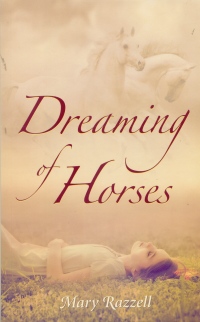| ________________
CM . . .
. Volume XX Number 20. . . .January 24, 2014
excerpt:
Dreaming of Horses is a prequel to two earlier novels by Mary Razzell. Snow Apples, published in 1984, is a coming-of-age novel about a 14-year-old Sheila Brary rebelling against her mother and getting pregnant. Salmonberry Wine, published in 1987, shows 17-year-old Sheila training as a nurse in Vancouver. Both novels were “Highly Recommended” for adolescent readers, with the latter novel recommended for readers 15 and up by the Canadian Materials reviewer. Dreaming of Horses, "based on the author's life," (according to the cover blurb) goes back in time, opening in 1937 when Sheila Brary is seven and living in Calgary. Growing up in Depression poverty with family tension and an angry mother, Sheila identifies with Dad, the adventurous, charming parent, and she misses him during his frequent absences. For that reason, her mother dislikes her. Gradually, though, Sheila realizes that her father has feet of clay. When Sheila's mother sends her to the priest to discuss her attitude, Father Kelly puts the situation in a nutshell. He tells Sheila that her father is a "grand sort of man. But not a marrying man...let's just say that it's hard for him to settle down." Sheila's mother is a decent, hard-working woman, "having to be both mother and father to you children and in these hard times, too." Sadly, neither Father Kelly nor other kindly adults, like her teachers and the neighbours, can rescue Sheila. Mary Razzell gradually reveals that fun-loving Dad, the seemingly nicer parent, is a seriously flawed person. Sheila has a recurrent memory from when she was three and a half, when her father came home drunk in the middle of the night and tried to force himself on her pregnant mother. Her mother screams to the children for help. The neighbours, hearing a disturbance, call the police.
Sheila's only solace is in nature and in art, at which she excels in school. Following her through one disappointment after another, readers see that the situation is unlikely to improve. Her father uses her as a cover when he goes out to see other women. When one, Irene, makes Sheila a costume that Mom can't afford to provide, Sheila tries to hide the origins of the outfit - unsuccessfully. Meanwhile, Dad tells everyone that Mom is crazy. When Mom is hospitalized with a mastoid infection, Dad moves his paramour into the house to look after the children. The housekeeping deteriorates. One day, Sheila finds the toddler, Andy, with a mysterious bruise on his forehead. Dad says it was from a fall from his high chair. Eventually, Sheila decides that she "owes her loyalty to Mom." Throughout the novel, horses are a symbol, sometimes of freedom, other times of victimhood. The novel opens with the death of three aged, gaunt horses in a stable fire that resulted from a bonfire set by neighbourhood boys. Their horrible end traumatizes Sheila because she stole matches from Mom to give to the boys. Her mother finds out and tells her she is to blame for the horses' death, a notion from which her father absolves her. The worn-out horses are something like Sheila's mother, except that the horses are good-natured. Horses appear in a positive way at a merry-go-round, in encountering a friend's horse, Star, and at the Calgary Stampede, which the Brarys attend, a rare outing as a family. Throughout the novel, though, the memory of the dead horses haunts Sheila. I kept hoping that the story would end on an upbeat note, with a whole-hearted mother-daughter reconciliation scene or a depiction of Sheila happy as a young adult, but I realized that this expectation was impossible. Even though a novelist can invent, Razzell couldn't create a happy ending for this prequel because she was bound by the plots of Snow Apples and Salmonberry Wine which involve mother-daughter enmity and Sheila's continued unhappiness. The last part of Dreaming of Horses is slightly more upbeat in that the family moves to a beautiful natural environment with plentiful food. Canada's entry into World War II in 1939 is an ill wind that blows some good to Mom and the children. In the epilogue, Razzell tells redaers that Sheila's brothers provided some material improvements in Mom's life. In a final scene, Sheila accepts a psychiatrist's opinion that her mother was not crazy but overburdened and traumatized by misfortunes. If a novel for young people cannot have a happy ending, it should at least conclude with redemption and hope. The psychiatrist's opinion redeems Mom in Sheila's eyes, but there is little in Dreaming of Horses that uplifts. The novel is compelling and well-written, with a style and vocabulary that many 10 to 12-year-olds could comprehend, but, because it is so depressing, it feels unsuitable for anyone under 16. Recommended. Ottawa’s Ruth Latta is working on a sequel to her teen novel, The Songcatcher and Me.
To comment
on this title or this review, send mail to cm@umanitoba.ca.
Copyright © the Manitoba Library Association. Reproduction for personal
use is permitted only if this copyright notice is maintained. Any
other reproduction is prohibited without permission.
NEXT REVIEW |
TABLE OF CONTENTS FOR THIS ISSUE
- January 24, 2014.
AUTHORS |
TITLES |
MEDIA REVIEWS |
PROFILES |
BACK ISSUES |
SEARCH |
CMARCHIVE |
HOME |
